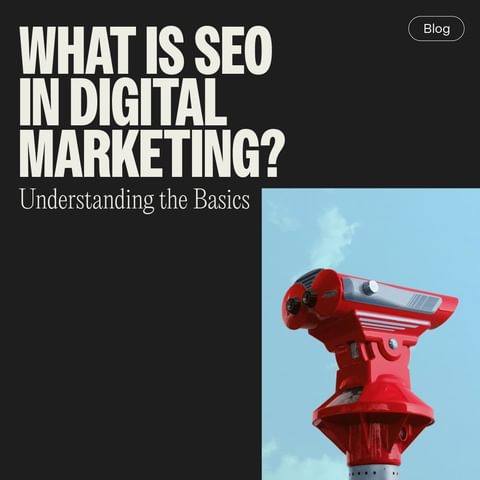NEWS ALERT - We won a SILVER IPM award for Best use of Social Media, 2025! Read more🏆

The marketing world has changed dramatically in recent years ago, and more businesses are using digital methods in their strategies. Understanding SEO (Search Engine Optimisation) is essential for anyone looking to boost their online presence. From increasing your website’s visibility to driving more organic traffic, mastering SEO can give your brand the competitive edge it needs.
In this blog, we’ll break down the basics of SEO, explore how it fits into your overall marketing strategy and uncover key components to help you navigate the complex world of search engines.

SEO stands for Search Engine Optimisation. It's the practice of optimising your website and its content to increase visibility and ranking on search engine results pages (SERPs). The primary goal of SEO is to attract organic, or unpaid traffic from search engines like Google, Bing, and Yahoo.
Google alone processes approximately 99,000 search queries every second so ensuring your website is easily found could be the key to your business success. In essence, SEO is about making your website more appealing to search engines, which in turn makes it easier for potential customers to find you when they're searching for products or services like yours.
SEO is a fundamental pillar of digital marketing. When potential customers search for products or services related to your business, SEO helps ensure that your website appears prominently in their search results.
In the broader scope of digital marketing, SEO plays a crucial role in driving organic traffic to your site. Unlike paid advertising, where you directly pay for visibility, SEO focuses on earning that visibility naturally. This makes it a cost-effective strategy for long-term growth. By improving your site’s relevance and authority through high-quality content, strategic keyword use, and robust link-building, SEO enhances your site’s chances of ranking higher in search results.
SEO fits into the overall marketing strategy by complementing other digital efforts such as content marketing, social media marketing, and pay-per-click (PPC) advertising. For instance, content marketing relies heavily on SEO to ensure that the created content reaches a broad audience. Social media can boost your SEO efforts by driving traffic to your site, and insights from PPC campaigns can inform your SEO strategy by revealing valuable keywords.

SEO involves multiple factors that all work together to improve a website’s search engine ranking. Below we’ve listed some key parts of SEO every digital marketer needs to know:
On-page SEO refers to the optimisation techniques applied directly within your website to improve its visibility and relevance to search engines. This includes:
Keyword Optimisation: Using relevant keywords that relate to your brand, products or services, naturally within your content, meta descriptions, headings, and URLs.
Content Quality: Creating high-quality, informative, and engaging content that meets the needs of your audience.
Meta Tags: Crafting effective meta titles and descriptions that accurately describe your content and entice users to click.
URL Structure: Creating clear, concise, and descriptive URLs that include target keywords.
Internal Linking: Linking to other relevant pages within your site to improve navigation and signal the importance of specific pages to search engines.
Off-page SEO involves activities outside your website that influence your site's search engine rankings. This mainly focuses on:
Backlinks: Acquiring high-quality backlinks from reputable websites to enhance your site's authority and trustworthiness.
Social Signals: Leveraging social media platforms to increase your content's visibility and attract more traffic to your site.
Brand Mentions: Encouraging mentions of your brand on external sites, which can indirectly contribute to your SEO efforts.
Technical SEO focuses on optimising the backend of your website to ensure that search engines can crawl and index your site effectively. Key aspects include:
Site Speed: Ensuring your site loads quickly to provide a better user experience and meet search engine criteria.
Mobile-Friendliness: Making sure your site is responsive and provides a seamless experience across all devices.
XML Sitemaps: Creating and submitting an XML sitemap to help search engines understand your site structure and index it more efficiently.
Robots.txt: Using the robots.txt file to control which pages search engines can crawl.
Secure Sockets Layer (SSL): Implementing HTTPS to secure your site and gain a ranking boost from search engines.
Local SEO is crucial for businesses that operate in specific geographic areas. It involves optimising your online presence to attract local customers. Key elements include:
Google My Business: Setting up and optimising your Google My Business profile to appear in local search results and Google Maps.
Local Citations: Ensuring your business name, address, and phone number (NAP) are consistent across all online directories and listings.
Reviews and Ratings: Encouraging satisfied customers to leave positive reviews on Google and other review platforms to build credibility and trust.
Content marketing and SEO go hand-in-hand. Producing high-quality, relevant content regularly can drive organic traffic and improve your search engine rankings. This includes:
Blog Posts: Writing informative and engaging blog posts that address the needs and interests of your target audience, whilst also using your target keywords naturally. Our blog page is a good example of this, we write pieces of content we believe interest our audience and use it to help us be visible.
Videos and Infographics: Creating visual content that can be shared and linked to, enhancing your site's authority.
Guides and E-books: Offering in-depth resources that provide value to your audience and encourage backlinks.
Google uses over 200 factors in their algorithm when it comes to ranking websites, so understanding and implementing these key components of SEO will help you create a well-rounded and effective strategy that improves your website's visibility, drives organic traffic, allows search engines to find you easily and ultimately contributes to your business's success.
To understand how to optimise your website for search engines, it's essential to grasp the basics of how search engines work. Search engines like Google, Bing, and Yahoo use complex algorithms to discover, index, and rank web pages based on relevance and authority. Here's a simplified breakdown of the process:
Crawling is the first step in the process where search engines send out bots (also known as spiders or crawlers) to discover new and updated content on the web. These bots follow links from one page to another, collecting data about each page they visit.
Discovery: Crawlers find web pages through links from other sites or by following links within your site.
Frequency: The frequency of crawling depends on the website's update rate and importance; high-traffic sites are crawled more often.
Once a page is discovered, search engines analyse its content to understand what it is about and store this information in their index.
Content Analysis: Search engines examine the text, images, videos, and other elements of a page to determine its relevance.
Metadata: Information like meta titles, descriptions, and tags are also analysed and stored.
Organising: The indexed pages are organised and stored in a way that allows for quick retrieval when a related search query is made.
When a user types a query into a search engine, it retrieves relevant pages from its index and ranks them based on several factors. This determines the order in which search results are displayed.
Relevance: How closely the content of a page matches the search query. This involves keyword usage and context.
Authority: The credibility of a page, often determined by the quality and quantity of backlinks from other reputable sites.
User Experience: Factors like page load speed, mobile-friendliness, and site structure affect rankings.
Engagement: User interactions, such as click-through rates and time spent on a page, also influence rankings.
The final step is delivering the search results to the user. Search engines aim to provide the most relevant and authoritative results based on the query.
Search Engine Results Pages (SERPs): These are the pages displayed by search engines in response to a query, including organic results, paid ads, and other features like knowledge panels or snippets.
Continuous Updates: Search engines constantly update their algorithms to improve the relevance and accuracy of search results.

SEO is a game-changer for boosting online visibility and driving organic traffic. By optimising your website with strategic keywords, quality content, and effective link-building, you can secure higher rankings in search engine results. Understanding and implementing these SEO fundamentals will empower your business to stand out and succeed online. However, it’s key to remember that SEO is a marathon, not a sprint, you won't see results overnight. Good SEO takes time and planning, although the return on your efforts will be shown as you begin to climb the ranks.
If you need any help with your digital marketing strategy, get in touch with the team today.